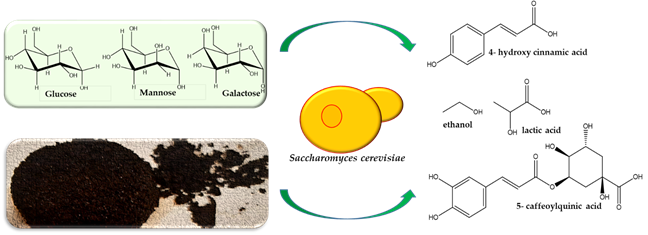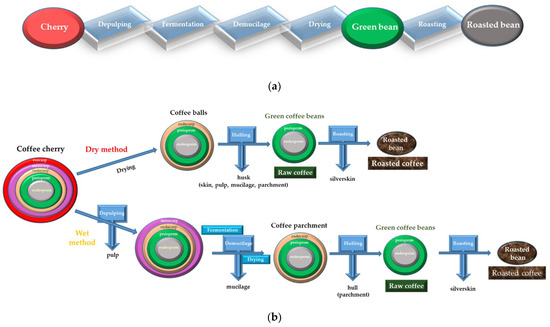Coffee is one of the most consumed beverages in the world, and its popularity has prompted the necessity to constantly increase the variety and improve the characteristics of coffee as a general commodity. The popularity of coffee as a staple drink has also brought undesired side effects, coffee production, processing and consumption are all accompanied by impressive quantities of coffee-related wastes which can be a threat to the environment. In this review, we integrated the main studies on fermentative yeasts used in coffee-related industries with an emphasis on two different directions: (1) the role of yeast strains in the postharvest processing of coffee, the possibilities to use them as starting cultures for controlled fermentation and their impact on the sensorial quality of processed coffee, and (2) the potential to use yeasts to capitalize on coffee wastes - especially spent coffee grounds—in the form of eco-friendly biomass, biofuel or fine chemical production.
1. Introduction
Along with tea, coffee is one of the most important habitual and social beverages in the modern world. Coffee represents an essential worldwide commodity and the major export commodity in around 70 tropical and subtropical countries [1]. In December 2020, the United States Department of Agriculture forecast the world coffee production for 2020/2021 at 175.5 million bags (60 kg per bag), which represents an increase of 7 million bags compared to the previous year [2]. The world market is dominated by two species of coffee: Coffea arabica (Arabica) and Coffea canephora (Robusta). Arabica is native to Ethiopia, while Robusta is native to Central Africa.
Due to the high content of caffeine and of other valuable nutraceuticals such as caffeic acid, chlorogenic acid and a plethora of other polyphenols with antioxidant proprieties, coffee has important and well documented pharmacological significance. The chemical composition (organic acids, sugars, aromas including heterocyclic compounds) determines the strength, the taste and the flavor, but the quality of the coffee also depends on physical factors (size, color and defective beans) [5].
Yeasts, especially from the genus Saccharomyces, have been used since ancient times for baking, brewing, distilling, winemaking and other fermented beverage production (e.g., sake, palm wine) [8]. S. cerevisiae is one of the most studied microorganisms in both fundamental and industrial research, and the study of S. cerevisiae under wine fermentation conditions is one of the oldest and most representative research in biotechnology [9]. The natural habitats of yeasts include fruits, cacti, the bark of trees, soil, etc. A multitude of strains have been isolated from different sources and environments (industrial, laboratory, wild isolates); among numerous sources, yeasts were also isolated from unroasted coffee [10]. S. cerevisiae is highly used in the fermentation processes involved in coffee production or valorization of coffee waste residue. Besides S. cerevisiae, numerous yeast species from different genera have been detected in the coffee processing steps, which include Pichia, Candida, Saccharomyces and Torulaspora [11,12]. The coffee’s aroma is the result of a mix of over 800 volatile chemical compounds.
2. Yeasts and Coffee Processing
The ripe coffee fruit used to obtain the coffee beans is called coffee cherry or coffee berry. The bean itself is the seed/pit inside the cherry, and—when roasted and ground—the source of the coffee beverage. The steps followed from cherry harvesting to obtaining the final product (roasted coffee) are presented in a. The structure of the coffee cherry consists of the outer skin (pericarp), silverskin (perisperm) and coffee seed (endosperm) (b, left). The pericarp consists of three layers, which from outside are: the exocarp (pulp), mesocarp (mucilage) and endocarp (parchment) [
4].
Figure 1. From coffee cherry to coffee bean. (
a) The main steps followed to obtain coffee beans. (
b) The fate of coffee fruit on the road to roasted beans. The structure of coffee cherry consists of the outer skin (pericarp), silverskin (perisperm) and coffee seed (endosperm). The pericarp represents the outer three layers of the fruit: the exocarp (pulp), mesocarp (mucilage) and endocarp (parchment) [
4]. In the dry method (top) commonly used for Robusta varieties, the coffee cherries are sun-dried until the moisture content is between 10% and 12%. The dried cherries are called coffee balls. In the wet method (bottom), applied mainly for Arabica varieties, the cherries are de-pulped to remove the skin and pulp. The resulting beans remain covered with a gluey texture similar to honey, the mucilage, which is subsequently removed by fermentation. After washing and drying to moisture content 10% to 12%, the coffee parchment is obtained, which represents the coffee beans surrounded by their endocarp (parchment) and perisperm (silver skin). The hulling is the process where the hull (parchment, in the wet method) of the coffee parchment or husk of the coffee ball (in the dry method) is mechanically removed [
24]. The green coffee beans are obtained after hulling, and in the next step, the green beans are sorted and roasted [
25].
2.8. Special Compounds in Yeast-Fermented Coffee
In unprocessed coffee, fruits contain citric, malic and succinic acids, which are maintained during fermentation. Together with chlorogenic and quinic acids, they are the main acids in green coffee beans, favoring the sensorial characteristics of coffee [
11]. At the initial fermentation time, citric, malic, succinic, lactic, oxalic, isobutyric and isovaleric acids prevail, together with numerous volatiles compounds. After fermentation, the main compounds are acids (citric, oxalic and especially lactic acid), alcohols (2,3-butanediol, 2-heptanol, phenylethyl alcohol and benzyl alcohol) and aldehydes. In the batches inoculated with
S. cerevisiae and using the natural processing method, the presence of lactic, isobutyric and isovaleric acids were not detected, in contrast with the coffee processed using the pulped natural method. The utilization of selected yeasts proved to be an alternative for sensorial differentiation [
6].
Some terpenes—such as 2,3-dihydro-3,5-dihydroxy-6-methyl-4H-pyran-4-one, DDMP—described as an antioxidant compound [
52], are metabolites formed by biosynthesis during
S. cerevisiae fermentations, conferring special characteristics to the coffee (sweet, caramel and nut characteristics). Yeast-fermented coffees yield another special compound named Cicloteno (2-hydroxy-1-methyl cyclopentene-3-one), an alcohol formed by the Maillard reaction from the lactic aldehyde resulted from oxidation and/or degradation of fructose, responsible for maple or caramel-like odor [
32,
48,
53].
Many alcohols are produced by yeasts from intermediates of amino acid metabolism, such as oxy-acids, subsequently subjected to formation of esters through an esterification reaction between fatty acids and a molecule of alcohol. Ester formation may contribute to floral and fruity sensory notes of coffees [
54], and the use of yeasts, which have the potential to increase the esters contents, may have a positive impact on the quality of the coffee [
12,
20,
32].
As can be easily observed, the role of the starter cultures in the coffee fermentation process is to decrease the fermentation time, to improve the process control, to minimize the growth of toxigenic fungi and to increase the sensory quality by the production of metabolites that offer a special aroma to the final coffee product [
15].
3. Yeasts as Toolboxes for Capitalization of Coffee Wastes
The general consumption of coffee generates huge quantities of waste material all over the world and spent coffee grounds (SCG) represent the main byproduct of the coffee industry. It is considered that more than 50% of beans are removed in the form of SCG after the extraction of the final product or instant coffee making process [
55]. Additionally, coffee residue wastes are generated by cafeterias (coffee shops, restaurants, etc.) and coffee factories. Numerically, 1 ton of green coffee generates about 650 kg of SCG and about 2 kg of wet SCG are obtained from each 1 kg of instant coffee produced [
56]. In the coffee-producing countries, there is a critical need for improving the technologies used for waste coffee treatment in order to prevent ecological damage [
57], and new strategies are considered to convert the coffee wastes into useful products. The coffee waste materials contain high amounts of hemicelluloses and lignin [
55] that could generate high-value products including biofuels (e.g., biodiesel, bioethanol) and fine chemicals (lactic acid, polyhydroxy alkanoate) [
58].
3.3. Spent Coffee Grounds and Fine Chemicals
Some possible utilization of SGC to obtain various organic chemicals is presented in . The valorization of wastes in the form of lactic acid received increased attention due to intensive use of lactic acid in different industries—cosmetic, chemical (polylactic acid a biodegradable plastic), pharmaceutical and even in food production [
73].

Figure 2. Capitalization of spent coffee waste. Applying different methods of treatment, the spent coffee waste (rich in glucose, mannose or galactose) can be turned into industrial by-products such as bioethanol, lactic acid or 5-cafeoylquinic acid.
Lactic acid is a primary product of bacterial fermentation. Because the lactic acid bacteria have a low tolerance to toxic compounds,
S. cerevisiae—whose tolerance to toxic compounds is higher—is often preferred [
68]. SCG as a substrate for lactic acid production through fermentation by
S. cerevisiae is possible only by engineered strains expressing heterologous lactate dehydrogenase [
74]. The ability of the engineered
S. cerevisiae strain to generate lactic acid and ethanol from SCG was assayed comparatively with the whole slurry containing different types of fermentable sugars and it was revealed that SCG with a substantial amount of hemicelluloses could be transformed into lactic acid and ethanol and that lactic acid production was promoted by xylose addition [
74].
In a study on the possibility to use yeasts for capitalization of coffee pulp, eight yeast strains cultivated in a mixture were analyzed in a semi-dry process. It was observed that a strain of
Hanseniaspora uvarum showed high potential for fermentation of coffee residues with a good yield of ethanol production, also yielding an important number of valuable compounds (higher alcohols, acetates, terpenes, and aldehyde) [
75].
Rhodotorula mucilaginosa CCMA 0156, a pigmented yeast, able to grow on husk and pulp coffee, was proved to be a strong candidate to produce higher biomass and in the same time, carotenoids, especially β-carotene. The carotenoids from coffee pulp had antioxidant and antimicrobial characteristics, adding valuable proprieties to those substances, mainly used as colorants [
76].
4. Concluding Remarks
As coffee consumption constantly increased all over the world, the quality of coffee became an important aim of food product research. In this review, we presented the most representative studies set to reveal the importance of various yeast strains used in the fermentative steps of post-harvest coffee processing, with a focus on how the interplay between yeast fermentative traits, strain selection and variation of processing methods can influence the quality of the final product. A significant number of studies presented in this review revealed the importance of yeast starters in influencing the sensory characteristics of the coffee. Special attention was paid to yeast fermentation processes which afforded extracellular enzymes secretion and production of various valuable organic compounds which contribute to the organoleptic traits of coffee products. This review also presented studies dealing with the involvement of yeasts in biotechnologies related to the processing of the ever-increasing coffee waste residues and how natural or engineered yeasts can be used to process the coffee wastes to produce valuable products such as processed biomass, bioethanol or biodiesel, or valuable chemicals such as reducing sugars, lactic acid, polyphenolic antioxidants, etc. In conclusion, the use of yeasts in the coffee-related industries is relevant and has a dualistic valence: contributing to improve and diversify the sensorial quality of coffee and, at the same time, emerging as a tool for capitalization of cumbersome coffee wastes, such as spent coffee grounds.
This entry is adapted from the peer-reviewed paper 10.3390/fermentation7010009


